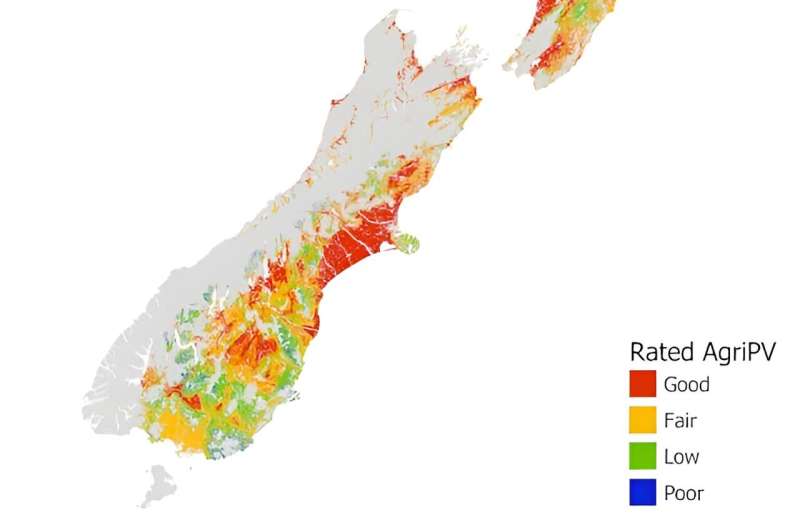
Solar farms can eat up farmland—but 'agrivoltaics' could mean the best of both worlds for NZ farmers

New Zealand plans to commission about eight gigawatts of solar photovoltaic projects—more than the maximum power demand of the whole country on a typical winter's day—by 2028, according to the government's latest generation investment survey.
Eight of these solar farms are already operational and spread across the country. More than 40 are in various stages of development, with the construction of the largest single project, in excess of 150 megawatts, due to start this year.
Solar farms are not without challenges, though. They can use up farmland and change the rural landscape. However, we argue that more efficient farms can integrate solar panels and agricultural production, with economic benefits for farmers.
Given Aotearoa New Zealand's current solar generation capacity of just under ten gigawatts, the increased generation is a significant development in the electricity sector and a positive contribution to the 2030 target of 100% electricity generation from renewables.
However, opposition has focused on the potential changes to the rural landscape and the use of productive soils.
This is especially because solar farms are likely to be proposed for fast-track consenting. Infrastructure Minister Chris Bishop has signaled the process will "make it easier to consent new infrastructure, including renewable energy."
We advocate a suitable option for New Zealand lies in "agrivoltaics"—using agricultural land for both renewable electricity generation and farming.
Addressing concerns over land-use change
In a country where half of its area serves agricultural purposes, land-use change is an obvious concern. The answer may well be agrivoltaics, which is gaining traction globally.
It means using rural land for both electricity generation and agriculture (including horticulture). Large areas of the country have been shown to be suitable for this dual land-use approach.
The major benefit of agrivoltaics is the micro-climate created under the solar arrays, with cooler temperatures during warm days and warmer temperatures at night. This results in less heat stress and less frost damage for crops.
Soils also retain more moisture, which means certain crops grow better, even with more shading. Pastoral production has seen the greatest benefits globally because animals are better protected from the elements, need less water and can access pasture in dry conditions.
Solar grazing
The integration of solar arrays with sheep farming is a major opportunity for New Zealand. Indeed, it is common practice to utilize sheep to maintain vegetation between and underneath the solar panels. This is a growing business in its own right, known as solar grazing.
The economics are quite compelling. A case study on a Canterbury farm shows the profitability of the solar assets with an additional revenue stream for the farmer from leasing agreements.
Given the economic worries sheep farmers are facing, this should be a definite consideration.
This article is republished from The Conversation under a Creative Commons license. Read the original article.![]()
Citation: Solar farms can eat up farmland—but 'agrivoltaics' could mean the best of both worlds for NZ farmers (2024, June 6) retrieved 6 June 2024 from https://techxplore.com/news/2024-06-solar-farms-farmland-agrivoltaics-worlds.html
This document is subject to copyright. Apart from any fair dealing for the purpose of private study or research, no part may be reproduced without the written permission. The content is provided for information purposes only.